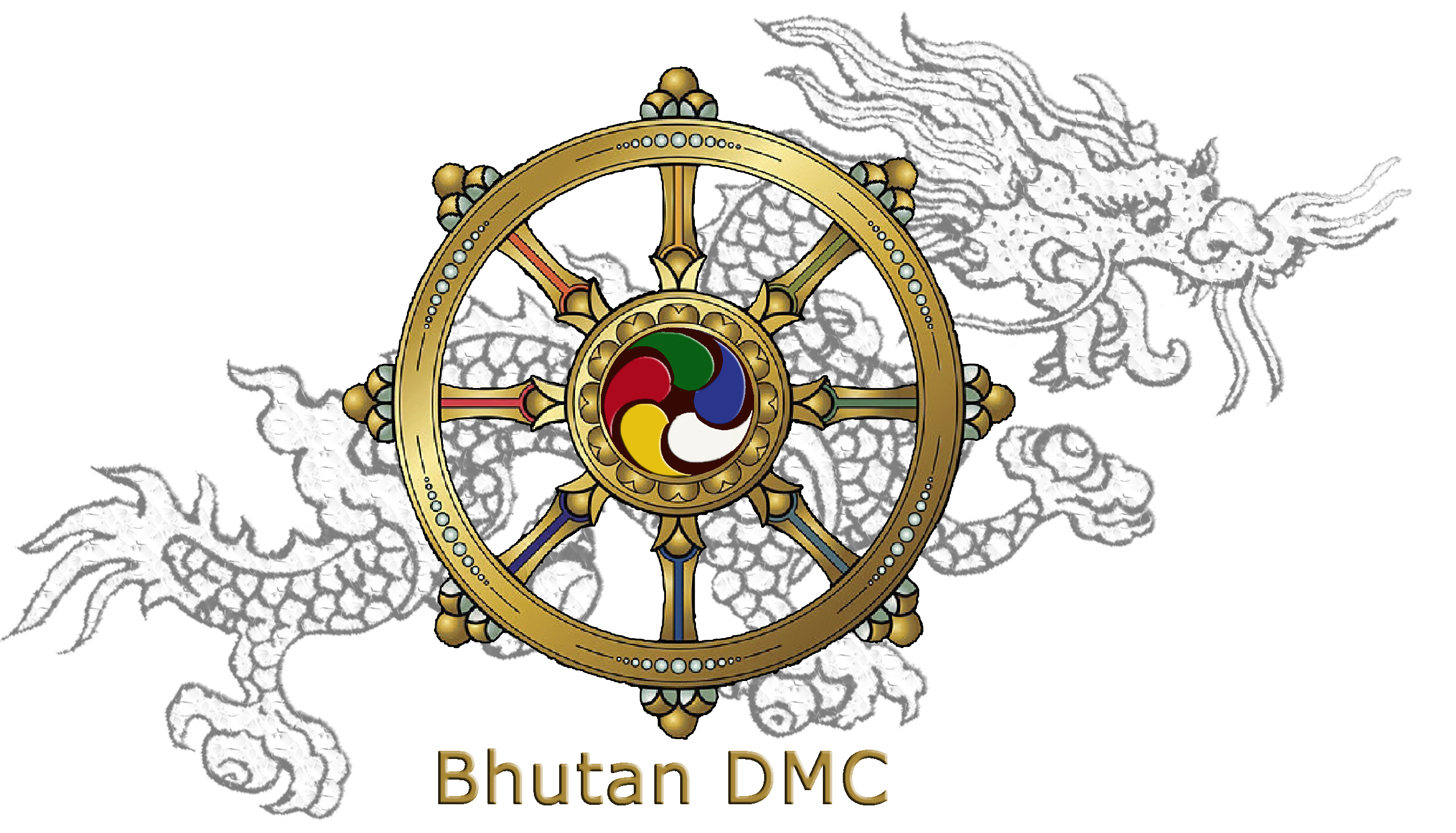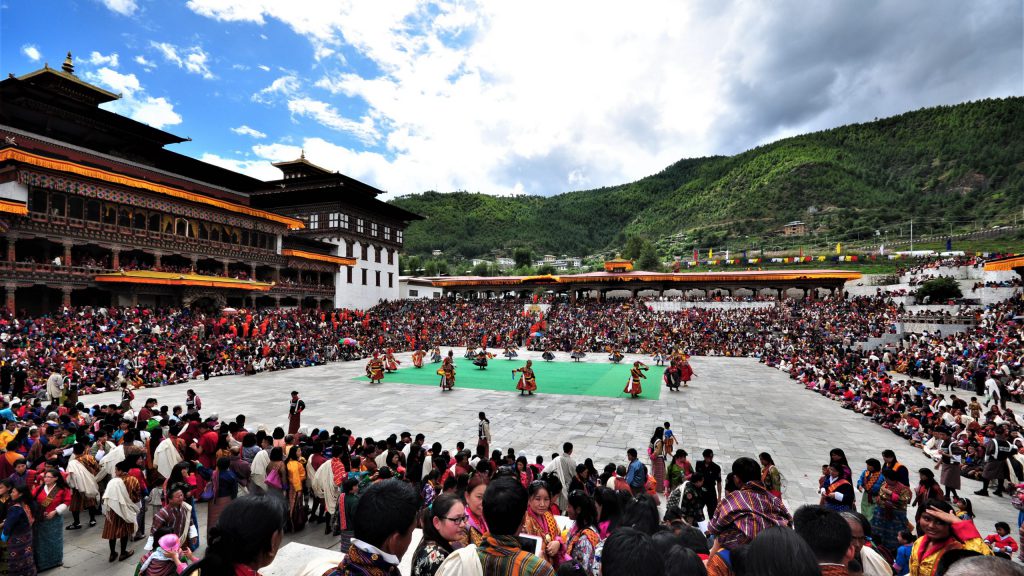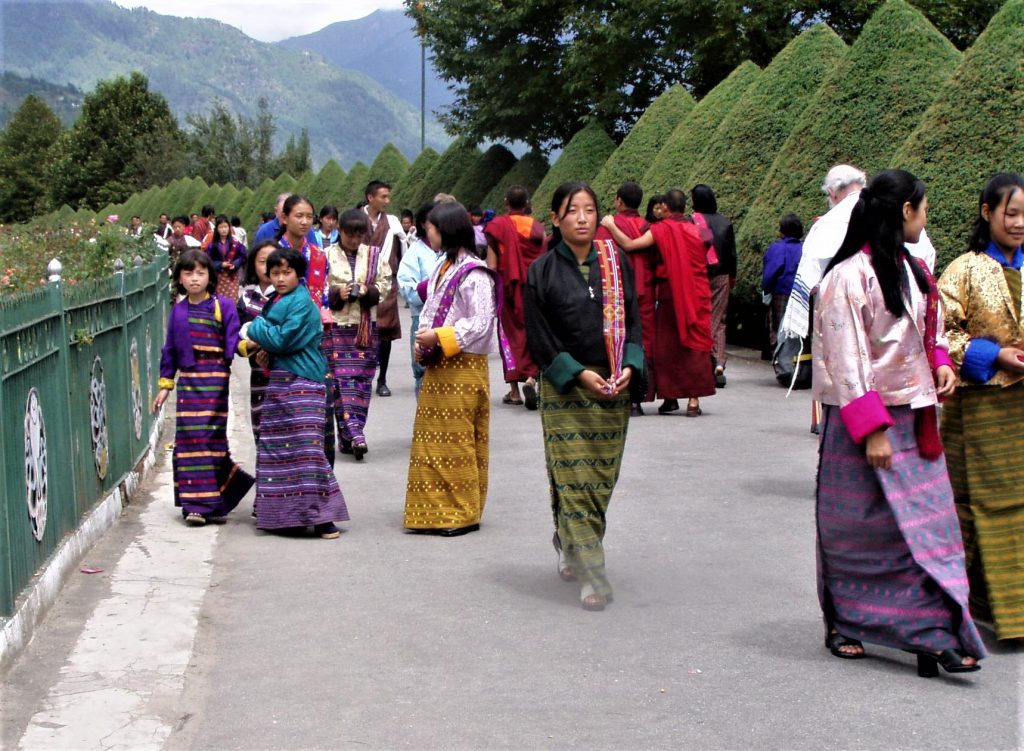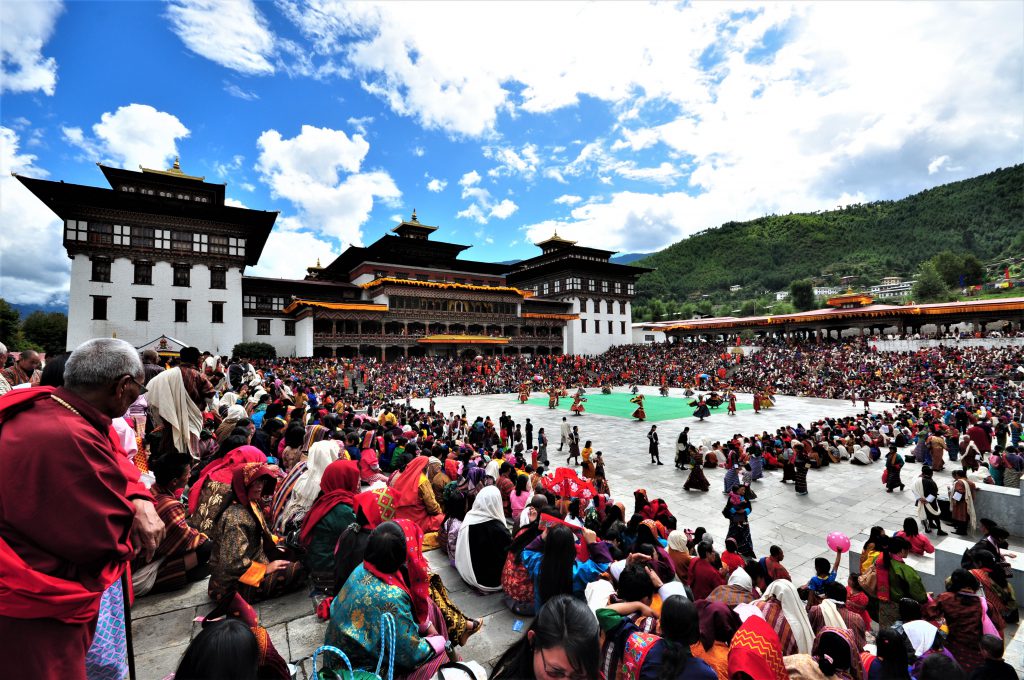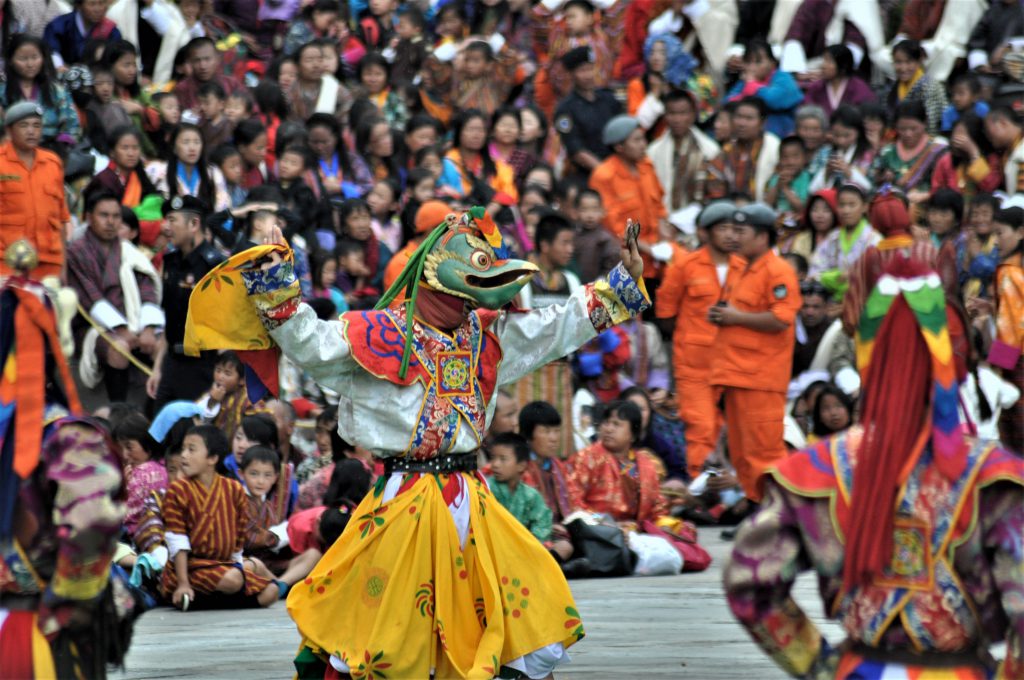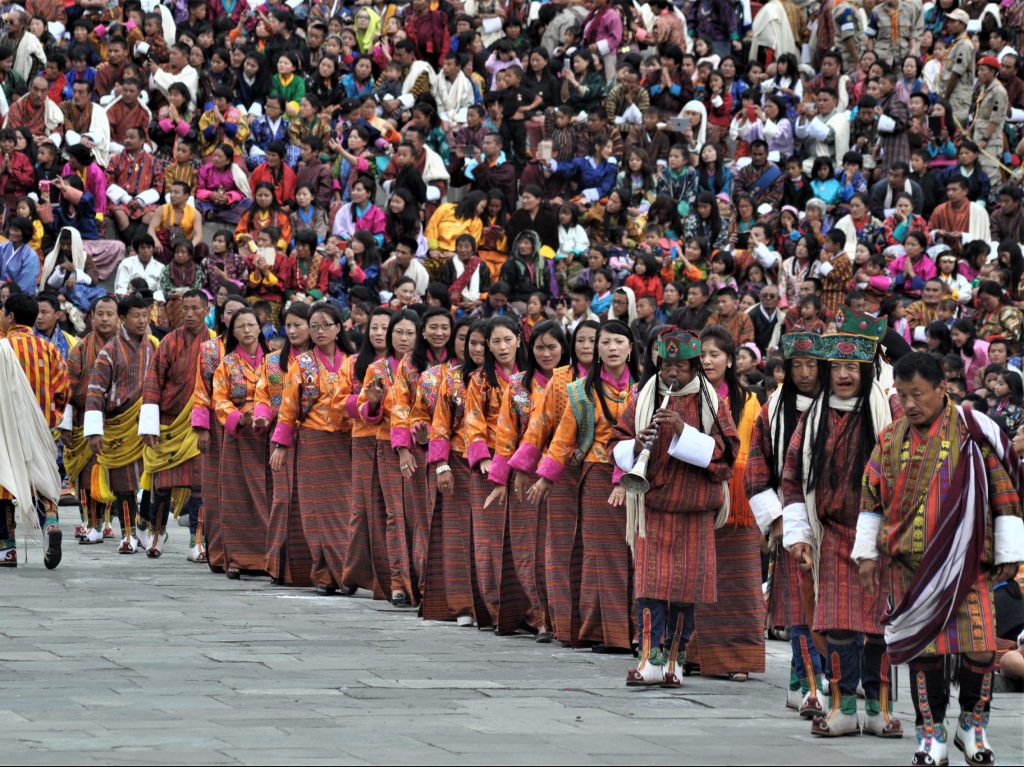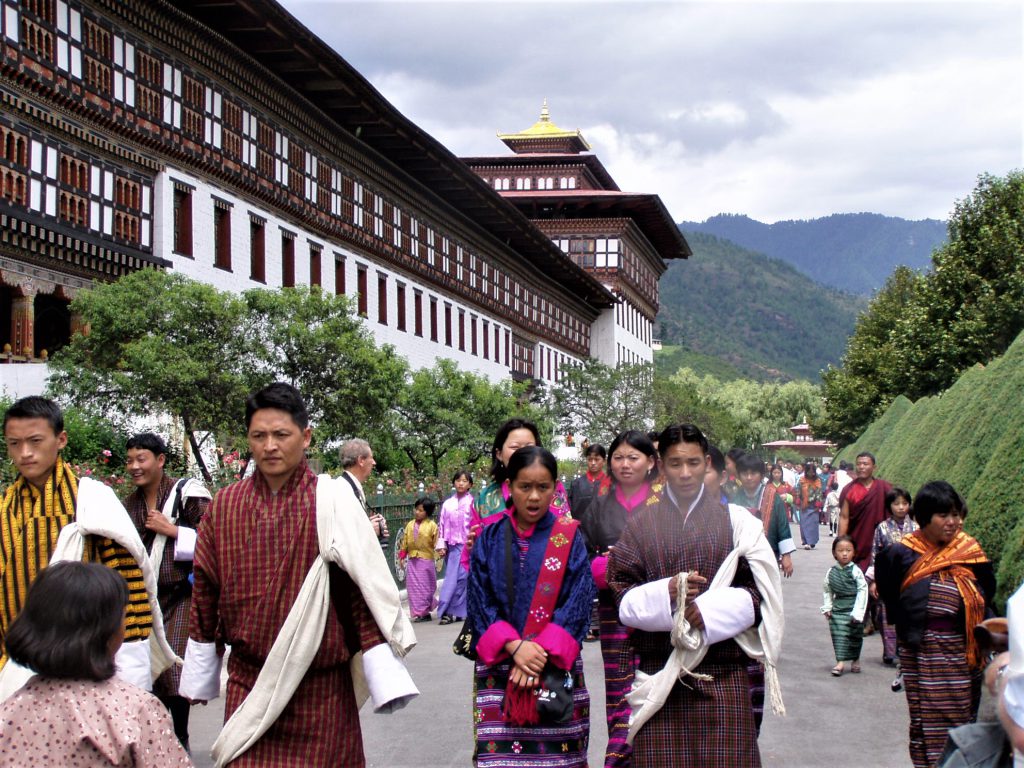Thimphu Tshechu is one of the biggest festivals celebrated for three days. During this festival, various masked dances performed depicting many religious events from the life of Guru Rimpoche. People from all walks of life come to attend this festival in their best attire and it is moment to rejoice and have merry & fun. While witnessing festival, you will sit around with locals, interact with them and take colourful pictures.
Day 1
Arrive Paro by Flight
The flight to Paro on a clear day is one of the most spectacular of all mountain flights. Whether flying along the Himalayan range from Kathmandu or over the foothills from Kolkatta, the journey offers fascinating views and an exciting descent into the Kingdom. The first gift from Bhutan will be cool, clean fresh air as you step out of the aircraft. You will be received by our representative and transfer to the hotel.
Later in afternoon visit, Ta Dzong: once a watchtower, built to defend Rinpung Dzong during inter-valley wars of the 17th century, Ta Dzong was inaugurated as Bhutan’s National Museum in 1968. It holds fascinating collection of art, relics, religious thangkha paintings and Bhutan’s exquisite postage stamps. The museum circular shape augments its varied collection displayed over several floors.
Then, walk down a hillside trail to visit Rinpung Dzong, which has a long and fascinating history. Built in 1646 by Shabdrung Ngawang Namgyal, the first spiritual and temporal ruler of Bhutan, the Dzong houses the monastic body of Paro, the office of the Dzongda (district administrative head) and Thrimpon (judge) of Paro district. It is also the venue of Paro Tshechu, held once a year in the spring.
Evening taken an exploratory walk around Paro main street.
Overnight at the hotel in Paro. (Altitude 2,280m)
Day 2
Paro After breakfast excursion to Taktshang Lhakhang or Tiger’s Nest Monastery (approx 5 hours round trip walk): Perched on the side of a cliff 900m above the Paro Valley floor, it is undoubtedly one of the most famous of Bhutan’s monasteries. Lore has it that Guru Rinpoche arrived here on the back of a tigress and meditated at this monastery thus the name ‘Tiger’s Nest’. This site has been recognized as a most sacred place and visited by Shabdrung Ngawang Namgyal in 1646 and now visited by all Bhutanese at least once in their lifetime. Late afternoon, drive to the farther end of the Valley to the base of Drugyel Dzong, a 17th century fortress burned down in the early 50s. Here we will also see the beautiful typical farmhouses, nicely painted. On the drive towards Paro town en route visit Kyichu Lhakhang, one of the oldest monasteries of the Kingdom reflecting introduction of Buddhism in Bhutan. Overnight at the hotel in Paro. (Altitude 2,280m)
Day 3
Paro – Punakha & Wangdue (125km, approx. 4-hour drive) After breakfast, drive to Punakha / Wangduephodrang across Dochu La. Located at a height of 3,088m/ 10,130 ft, Dochula is a scenic location with chorten, mani wall, and prayer flags which decorate this highest point on the road. If skies are clear, it may be possible to see the following peaks from this pass in the order left to right: Masagang (7,158m), Tsendagang (6,960m), Terigang (7,060m ), Jejegangphugang (7,158 m), Kangphugang (7,170 m ), Zongphugang (7, 060 m ), a table mountain that dominates the isolated region of Lunana – finally Gangkar puensum, the highest peak in Bhutan at 7,497m. En route visit Simtokha Dzong, one of the oldest fortresses of the country which now houses School for Buddhist studies. Afternoon visit Punakha Dzong or (Palace of Great Happiness), built in 1637 by Shabdrung Ngawang Namgyal, at the junction of the Phochu and Mochu rivers. This majestic dzong served as both the religious and the administrative center of Bhutan in the past. It measures some 600 by 240 feet and has a six-story, gold-domed tower. Inside are courtyards and religious statuary that hint at the depth of history and spiritual tradition embodied here. Your guide will illuminate your understanding of this intricate culture that is exotic to us, though long established here. Later in the day excursion to Chimi Lhakhang. The Chimi Lhakhang, situated on a hillock in the centre of the valley, is also known as the temple of fertility. It is widely believed that couples who do not have children and wanting one, if they pray at this temple, they are usually blessed with a child very soon. A walk through the village near the temple will give you rare glimpses into the daily life and lifestyle of the villagers. Overnight at the hotel in Punakha / Wangdue. (Altitude 1,300m)
Day 4
Punakha & Wangdue After breakfast, a beautiful hike (total about 2 hours round trip walk) takes you to the regal Khamsum Yuelley Namgel Chorten, which was built by the Queen Mother of Bhutan to remove negative forces and promote peace, stability and harmony in the changing world. The Chorten dominates the upper Punakha Valley with commanding views across the Mo Chhu river and up towards the mountainous peaks of Gasa and beyond. Afternoon visit to Sangchhen Dorji Lhuendrup Lhakhang (nunnery). Perched on a ridge amid pine trees and overlooking valleys of Punakha and Wangduephodrang, gleams the magnificent structures of Sangchhen Dorji Lhuendrup Lhakhang (Temple). The temple houses a 14-foot main bronze statue of Avalokiteshvara (Chenrigzig chagtong chentong). Other statues include those of Guru Padmasambawa, Gautama Buddha, Zhabdrung Ngawang Namgyel, Tsela Namsum, the 21 Taras and Tsepamay (Buddha of longevity). The Avalokiteshvara statue, one of the biggest in the country, was the handiwork of entirely local Bhutanese artisans. Later excursion to Talo village. The village of Talo (alt. 2,800m) which is scattered along the hill slopes, known for its cleanliness and hygiene among Punakha villages. Talo Sangnacholing is built on a plateau and has majestic view of surrounding villages. The beautiful farmhouses of the village have its own flower gardens, and, on the hill, slope corns and sweet peas are grown in abundance. Later in the afternoon drive back to Punakha / Wangdue, for overnight stay. (Altitude 1,300m)
Day 5
Punakha – Thimphu (75km, approx. 3-hour drive) After breakfast, drive to capital city Thimphu. Later visit King’s Memorial Chorten continuously circumambulated by people, murmuring mantras and spinning their prayer wheels. Construction of this landmark was the idea of Bhutan’s third king, His Majesty Jigme Dorji Wangchuk (“the father of modern Bhutan”) who has wished to erect monument to world peace and prosperity. Completed in 1974 after his untimely death, it serves both as a memorial to the Late King and as a monument to peace. Then drive to Buddha Point (Kuensel Phodrang). Located at a short drive from Thimphu city centre, visitors can get a good overview of the Thimphu valley from the Buddha point (Kuensel Phodrang). You can pay your obeisance and offer prayers to the Buddha, the largest statue in the country and then walk around and take a glimpse of the valley. Evening explore Thimphu city centre and local craft bazaar to browse through example of Bhutan’s fine traditional arts. Here you can buy hand-woven textiles, thangkha paintings, masks, ceramics, slate and wood carvings, jewelry, interesting items made from local materials. Overnight at the hotel in Thimphu. (Altitude 2,320m)
Day 6
Thimphu Full day witness Thimphu Tshechu (festival). Thimphu Tshechu, held in Bhutan’s capital city, was initiated by the 4th Temporal Ruler of Bhutan, Gyalse Tenzin Rabgay, in 1867. The festival underwent a change in the 1950s, when the third King Jigme Dorji Wangchuck, introduced numerous Boed Chhams (mask dances performed by monks). The addition also added colour without compromising the spiritual significance. Also visit Trashichhoedzong. This is the center of government and religion, site of monarch’s throne room and seat of Je Khenpo or Chief Abbot. Built in 1641 by the political and religious unifier of Bhutan, Shabdrung Ngawang Namgyal, it was reconstructed in 1960s in traditional Bhutanese manner, without nails or architectural plans. Overnight at the hotel in Thimphu. (Altitude 2,320m)
Day 7
Thimphu Morning witness Thimphu Tshechu (festival). During Tshechu, the dances are performed by monks as well as laymen wearing ornate costumes and masks; each aspect of dance has a symbolic meaning mostly depicting events from the life of Guru Padmasambhava. It is widely believed that one gains merit by attending any of religious festivals. This is followed by visit to Changangkha Lhakhang. It is a fortress like temple and monastic school perched on a ridge above Thimphu, south of Motithang. The temple was established in 12th century on a site chosen by Lama Phajo Drugom Shigpo, who came from Tibet. The central statue here is Chenrezig in a manifestation with 11 heads. From temple courtyard, there is fascinating view of Thimphu valley. After lunch, drive to BBS tower (Sangaygang viewpoint). From here commences approx two hours walk to Sangayang – Wangditse loop. Also visit Wangditse Goemba, founded in 1750 and later totally rebuilt in 2016. The inner chapel houses a two-storey statue of Sakyamuni Buddha. There are excellent views north towards the Samteling Palace, home to the fourth King. The walking tail ends back at Sangaygang viewpoint. Evening at leisure in Thimphu city centre. Overnight at the hotel in Thimphu.
Day 8
Paro airport (55km, approx. 1.1/2-hour drive) Morning transfer to the airport for flight to onward destination. Our guide will assist you with exit formalities and bid you farewell.
Image Gallery
